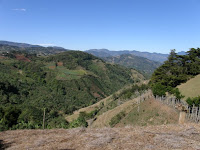Climate: hot and wet
Geography: flat
Nearby cities: Boca Arenal
Tagline: This is where your pineapples come from

I´m in the north, in the middle of the country (in the void above Pital on this map), 5+ hours from the nearest beach, and not far from Nicaragua. It´s good for biking, though. I´ll be working with the local development association, a rural eco-tourism group (if you want to visit...), a dairy cooperative, English students, a women´s group, and more. I´m about five hours from San Jose.
I´m in a town of about 250 (not counting cows) and I have (satellite) internet access, but no supermarket, no clinic, no municipal water system (everyone has wells). Peace Corps doesn´t want me to tell you the name of the town, but you get the idea. If you want to see pictures, I´ve already got a few--this is the site I visited in March.
I´m excited. The other good news: there´s no bakery yet in my town, so maybe I can start one. And if I´m really lucky I can start a agouti ranch.






















